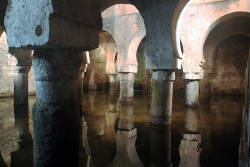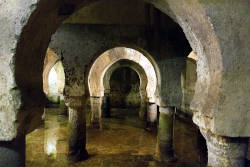Aljibe Andalusí
Aljibe of Cáceres - Aljibe del museo de Caceres - Museo de Cáceres y Aljibes
Useful Information

| Location: |
Museo de Cáceres y Aljibes, Plaza de las Veletas, 1, Cáceres.
(39.472716, -6.370277) |
| Open: |
All year Tue-Fri 9:30-14:30, 16-20, Sat 10-14:30, 16-20, Sun 10-15. [2020] |
| Fee: |
Adults EUR 1.20. Europeans free, On Sundays free, Children free, Students free, Seniors (65+) free. [2020] |
| Classification: |
 Cistern Cistern
|
| Light: |
 Incandescent Incandescent
|
| Dimension: | L=14 m, W=10 m, H=6.10 m, V=7,00 m³. |
| Guided tours: | n/a |
| Photography: | allowed |
| Accessibility: | no |
| Bibliography: | |
| Address: |
Aljibe Andalusí, Museo de Cáceres y Aljibes, Plaza de las Veletas, 1, 10003, Cáceres, Tel: +34-927-01-0877.
E-mail: |
| As far as we know this information was accurate when it was published (see years in brackets), but may have changed since then. Please check rates and details directly with the companies in question if you need more recent info. |
|
History
| 10th-11th century | cistern constructed. |
| 1899 | a group of scholars of the History of Cáceres began to collect objects of archaeological and artistic interest. |
| 1917 | first Board of Trustees of the Museum established. |
| 1931 | Palacio de Las Veletas rented to house the Museum. |
| 12-FEB-1933 | Cáceres Museum inaugurated. |
| 1971 | museum rehabilitated. |
| 1986 | inscribed on the UNESCO World Heritage List. |
| 1989 | Ministry of Culture transferred the management of the Museum to the Government of Extremadura. |
| 1992 | collection of Fine Arts inaugurated. |
| MAY-2023 | beginning of renovation, museum partially closed. |
Description


The Museo de Cáceres (Cáceres Museum) is located in two adjacent palaces. The Palacio de las Veletas houses the archeology and ethnography sections. The Casa de los Caballos houses the collection of Fine Arts. The best preserved Hispano-Muslim cistern in Spain is located below the Renaissance cloister of the Palacio de la Veletas. It is a remains of the Almohad military fortress which was replaced by the current building in the 16th century. The rain falling on the Renaissance patio is collected in the cistern until today. Claims that it was the biggest cistern of the world are obviously nonsense.
Aljibe Andalusí (Andalusian Cistern), also known as Moorish Cistern of Cáceres, is not as spectacular as many Roman or modern cisterns. The columns are massive, with thick vaults, and the floor is covered in water. Many people think it is small, because those pillars and walls obstruct the view, and the ceiling is not exceptionally high. The cistern was constructed on the highest point of the old city. This means it is possible to construct water channels to other houses in the city which work simply on gravitation.
The city was completely remodeled after it was reconquered. Most buildings of Islamic Cáceres were demolished and replaced by Renaissance buildings. This is not a bad thing, as those building are really nice. But it shows the inhabitants were mot willing to live in the architecture and culture of their former oppressors. But the cistern is unchanged, survived the cleansing unchanged, obviously a result of its functionality and importance. This city has always been characterized by its problems with the water supply. This is the most important but not the only cistern in town.
The cistern was constructed in the 10th to 11th century, together with the construction of the first Muslim defensive enclosure in the city. It was considered that it was built in the Almohad period, second half of the 12th century to the beginning of the 13th, but the importance to guarantee the water supply in the event of a military siege makes the earlier date more likely. The city of Cáceresa was incorporated into the kingdom of León by Alfonso IX in 1229. By order of the Infante Don Alfonso, proclaimed king, the fortress was demolished, King Enrique IV granted Diego Gómez de Torres and Alfón de Torres the mercy of building a house on the site of the cisterns. But only under the condition of maintaining the public easement of water, having to leave the use of water to the neighbors in time of need.
The cistern was originally constructed taking advantage of a depression on top of the hill. The northwest and northeast wall were actually dug into the rock, the floor was leveled by digging into the ground. The two remaining sides were closed with 1.5 m thick walls. This was necessary to resist the massive pressure of the water. The floor has a slight incline towards the southern side, probably made on purpose to allow emptying. However, the cistern is irregular, a result of the ground rock and the original surface. Even the columns and naves are not identical.
Do not omitt the museum when visiting the cistern, The building is interesting, and the archaeological collection is quite impressive. On section is about the history of cistern, the others show Palaeolithic lithological industries, Neolithic remains, various megalithic tombs, pre-Roman settlers, and much more. The most important section is about urban development, economy, religion and the funereal world during the Roman Empire.
- See also
 Subterranean World Heritage List
Subterranean World Heritage List Search DuckDuckGo for "Aljibe Andalusí"
Search DuckDuckGo for "Aljibe Andalusí" Google Earth Placemark
Google Earth Placemark OpenStreetMap
OpenStreetMap Museo de Cáceres, official website
Museo de Cáceres, official website  (visited: 23-OCT-2020)
(visited: 23-OCT-2020) Old Town of Cáceres (visited: 17-APR-2021)
Old Town of Cáceres (visited: 17-APR-2021) Museo de Cáceres y Aljibes (visited: 23-OCT-2020)
Museo de Cáceres y Aljibes (visited: 23-OCT-2020) Cáceres Museum (visited: 02-FEB-2024)
Cáceres Museum (visited: 02-FEB-2024) MUSEUM OF CÁCERES AND THE ALJIBE (visited: 04-JAN-2024)
MUSEUM OF CÁCERES AND THE ALJIBE (visited: 04-JAN-2024) Moorish Cistern of Cáceres (visited: 04-JAN-2024)
Moorish Cistern of Cáceres (visited: 04-JAN-2024)
 Index
Index Topics
Topics Hierarchical
Hierarchical Countries
Countries Maps
Maps